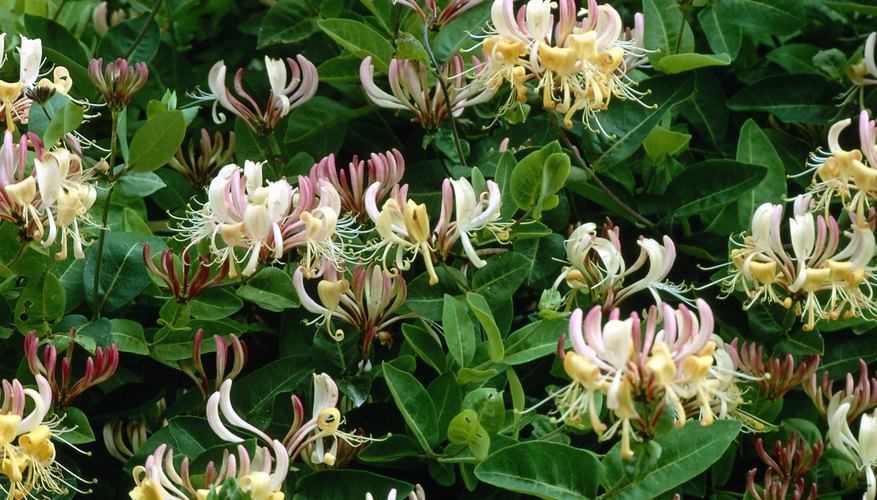Honeysuckle is a popular cottage garden plant in the southern half of England. Charles I's gardener, John Tradescant the Younger (1608-1662), first introduced honeysuckle to England when he brought the Lonicera sempervirens variety from its native Virginia. Gardeners choose honeysuckle for its heavily scented, trumpet-shaped blooms which are highly attractive to bees and other pollinating insects. Most honeysuckle cultivars are climbing, vine-like plants but there are a few which grow as a bush. Honeysuckle is quite hardy but it can succumb to pests and diseases, and needs special attention when it is first planted in the garden.
Watering
Your honeysuckle may suffer wilting leaves after a particularly long dry spell. This is especially true for new plants where the roots have not yet had time to grow deep enough. If the soil around the base of the plant is dry to the touch, water the area around the honeysuckle so that it is soaked. Don't leave standing water around the base of the plant. To lessen the impact of drought conditions, surround the base of the plant with two or three inches of mulch to help the soil retain water.
- Your honeysuckle may suffer wilting leaves after a particularly long dry spell.
- If the soil around the base of the plant is dry to the touch, water the area around the honeysuckle so that it is soaked.
Position
You can give your honeysuckle the best chance of thriving by choosing the correct position for planting. In the wild, honeysuckles are forest plants which grow with their base and roots in the shade and their upper branches climbing towards the sun. It also prefers a soil that is not too alkaline. Grow your honeysuckle in a spot where the roots will remain shaded and moist but the plant can scramble up a wall or a tree towards sunshine.
- You can give your honeysuckle the best chance of thriving by choosing the correct position for planting.
- Grow your honeysuckle in a spot where the roots will remain shaded and moist but the plant can scramble up a wall or a tree towards sunshine.
Powdery mildew
Honeysuckle can be prone to attacks of powdery mildew which will make its leaves discoloured and cause the plant to wilt. Powdery mildew is a fungal infection which is air-transmitted and you can recognise it by the white spots of mould that appear on leaves, which may become distorted before dying. You can reduce the risk of powdery mildew by ensuring the plant is well watered. If it does appear, prune out infected sections of the honeysuckle and burn them to prevent the disease spreading. You can also use fungicide sprays available from garden centres to control the condition.
- Honeysuckle can be prone to attacks of powdery mildew which will make its leaves discoloured and cause the plant to wilt.
- You can reduce the risk of powdery mildew by ensuring the plant is well watered.
Aphids
In the spring, new growth on your honeysuckle can be prone to attack by aphids. These tiny insects can descend in large numbers and they damage the plant by sucking out the sap which can lead to wilting leaves. Aphids also excrete a sticky liquid which covers the leaves and can lead to sooty mould, a fungal disease that will further blight the plant. Although aphids cause damage, they will seldom kill a plant and in many cases you can let nature take its course as natural predators such as ladybirds and birds will attack the aphids. You can use insecticides to kill the aphids, but this will also kill insect predators.
- In the spring, new growth on your honeysuckle can be prone to attack by aphids.
- These tiny insects can descend in large numbers and they damage the plant by sucking out the sap which can lead to wilting leaves.
